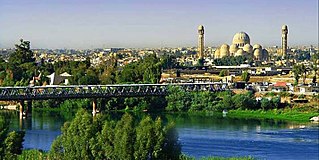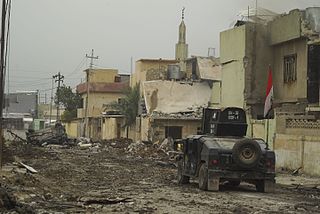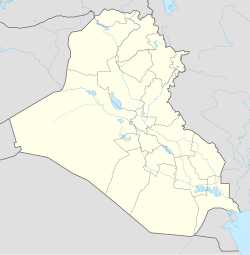
Nineveh or Ninawa Governorate is a governorate in northern Iraq. It has an area of 37,323 km2 (14,410 sq mi) and an estimated population of 2,453,000 people as of 2003. Its largest city and provincial capital is Mosul, which lies across the Tigris river from the ruins of ancient Nineveh. Before 1976, it was called Mosul Province and included the present-day Dohuk Governorate. The second largest city is Tal Afar, which has an almost exclusively Turkmen population.
Hajin is a small city in eastern Syria, administratively part of the Deir ez-Zor Governorate, located along the Euphrates River, south of Deir ez-Zor. Nearby localities include al-Abbas to the west, al-Ramadi to the south and Gharanij to the north. According to the Syria Central Bureau of Statistics, Hajin had a population of 37,935 in the 2004 census. It is the administrative center of a nahiyah ("subdistrict") of the Abu Kamal District. The Hajin subdistrict consists of four towns which had a collective population of 97,970 in 2004. The al-Shaitat tribe is the largest tribe in the area. The town was captured by the Syrian Democratic Forces on 14 December 2018 in the Battle of Hajin, after a week and a half of heavy clashes and intense airstrikes by the United States-led Combined Joint Task Force – Operation Inherent Resolve international coalition, and has since been part of the Autonomous Administration of North and East Syria.

The 2012–2013 Iraqi protests started on 21 December 2012 following a raid on the home of Sunni Finance Minister Rafi al-Issawi and the arrest of 10 of his bodyguards. Beginning in Fallujah, the protests afterwards spread throughout Sunni Arab parts of Iraq. The protests centered on the issue of the alleged sectarianism of Prime Minister Nouri al-Maliki. Pro-Maliki protests also took place throughout central and southern Iraq, where there is a Shia Arab majority. In April 2013, sectarian violence escalated after the 2013 Hawija clashes. The protests continued throughout 2013, and in December Maliki used security forces to forcefully close down the main protest camp in Ramadi, leaving at least ten gunmen and three policemen dead in the process.
The 2013 Hawija clashes relate to a series of violent attacks within Iraq, as part of the 2012–2013 Iraqi protests and Iraqi insurgency post-U.S. withdrawal. On 23 April, an army raid against a protest encampment in the city of Hawija, west of Kirkuk, led to dozens of civilian deaths and the involvement of several insurgent groups in organized action against the government, leading to fears of a return to a wide-scale Sunni–Shia conflict within the country. By 27 April, more than 300 people were reported killed and scores more injured in one of the worst outbreaks of violence since the U.S. withdrawal in December 2011.

The Islamic State of Iraq was a Salafi jihadist militant organization that fought the forces of the U.S.-led coalition during the Iraqi insurgency. The organization aimed to overthrow the Iraqi federal government and establish an Islamic state governed by Sharia law in Iraq.

Beginning in December 2012, Sunnis in Iraq protested against the Maliki government. On 28 December 2013, a Sunni MP named Ahmed al-Alwani was arrested in a raid on his home in Ramadi. Alwani was a prominent supporter of the anti-government protests. This incident led to violence in Al Anbar Governorate between the Iraqi Army and a loose alliance of tribal militias and other groups fighting alongside the Islamic State of Iraq and the Levant (ISIL).

The Northern Iraq offensive began on 4 June 2014, when the Islamic State of Iraq and Levant, assisted by various insurgent groups in the region, began a major offensive from its territory in Syria into Iraq against Iraqi and Kurdish forces, following earlier clashes that had begun in December 2013 involving guerillas.

The War in Iraq (2013–2017) was an armed conflict between Iraq and its allies and the Islamic State. Following December 2013, the insurgency escalated into full-scale guerrilla warfare following clashes in the cities of Ramadi and Fallujah in parts of western Iraq, and culminated in the Islamic State offensive into Iraq in June 2014, which lead to the capture of the cities of Mosul, Tikrit and other cities in western and northern Iraq by the Islamic State. Between 4–9 June 2014, the city of Mosul was attacked and later fell; following this, Prime Minister Nouri al-Maliki called for a national state of emergency on 10 June. However, despite the security crisis, Iraq's parliament did not allow Maliki to declare a state of emergency; many legislators boycotted the session because they opposed expanding the prime minister's powers. Ali Ghaidan, a former military commander in Mosul, accused al-Maliki of being the one who issued the order to withdraw from the city of Mosul. At its height, ISIL held 56,000 square kilometers of Iraqi territory, containing 4.5 million citizens.

The departure of US troops from Iraq in 2011 ended the period of occupation that had begun with the U.S.-led invasion in March 2003. The time since U.S. withdrawal has been marked by a renewed Iraqi insurgency and by a spillover of the Syrian civil war into Iraq. By 2013, the insurgency escalated into a renewed war, the central government of Iraq being opposed by ISIL and various factions, primarily radical Sunni forces during the early phase of the conflict. The war ended in 2017 with an Iraqi government and allied victory, however ISIL continues a low-intensity insurgency in remote parts of the country.
The Deir ez-Zor offensive was executed by the Islamic State of Iraq and the Levant, also known as ISIS, against all other opposition forces in the Deir ez-Zor Governorate as part of the Inter-rebel conflict during the Syrian Civil War.
The following lists events that happened during 2014 in Iraq.
In early 2014, the jihadist group Islamic State of Iraq and the Levant captured extensive territory in Western Iraq in the Anbar campaign, while counter-offensives against it were mounted in Syria. Raqqa in Syria became its headquarters. The Wall Street Journal estimated that eight million people lived under its control in the two countries.

The Shirqat offensive, codenamed Operation Conquest or Operation Fatah, was an offensive against the positions of the Islamic State of Iraq and the Levant (ISIL) in and around the district of Al-Shirqat District to reach the city of Mosul.
This is a timeline of events during the War in Iraq in 2016.
This is a timeline of events during the War in Iraq of 2013 to 2017 in its final year.

The 2017 Western Iraq campaign was the final major military operation of the 2013–2017 war in Iraq, in the western province of Anbar, and on the border with Syria, with the goal of completely expelling ISIL forces from their last strongholds in Iraq.

The Battle of Hawija was an offensive launched in September 2017 by the Iraqi Army, in order to recapture the town of Hawija and the surrounding areas from the Islamic State of Iraq and the Levant (ISIL).

The Eastern Syria campaign of September–December 2017 was a large-scale military operation of the Syrian Army (SAA) and its allies against the Islamic State of Iraq and the Levant (ISIL) during the Syrian Civil War. Its goal was to clear the city of Deir ez-Zor of any remaining ISIL forces, capture ISIL's de facto capital of Mayadin, as well as seize the border town of Abu Kamal, which became one of ISIL's final urban strongholds by the latter stages of the campaign.
This is a timeline of events during the Islamic State insurgency in Iraq (2017–present) in 2021.











